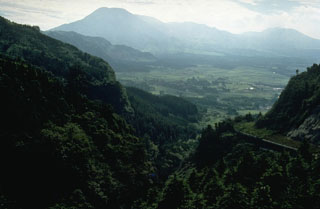Report on Asosan (Japan) — June 1985
Scientific Event Alert Network Bulletin, vol. 10, no. 6 (June 1985)
Managing Editor: Lindsay McClelland.
Asosan (Japan) Ejection of ash and incandescent tephra
Please cite this report as:
Global Volcanism Program, 1985. Report on Asosan (Japan) (McClelland, L., ed.). Scientific Event Alert Network Bulletin, 10:6. Smithsonian Institution. https://doi.org/10.5479/si.GVP.SEAN198506-282110
Asosan
Japan
32.8849°N, 131.085°E; summit elev. 1592 m
All times are local (unless otherwise noted)
Since October 1984, activity has gradually increased at Naka-dake, site of all of the more than 140 eruptions known from the Aso complex in historic time. Activity at Crater 1 increased in May. Ash accumulated at JMA's Asosan Weather Station on 12, 14, [16], 22, 23, 29, and 30 May (table 3). An ash-laden plume was observed almost daily (figure 7). On the morning of 6 May, incandescent blocks were ejected at a new vent that had not been present the previous day. Block ejection stopped on 8 May but resumed on 15 May, when the vent increased to 40 m diameter by collapse of a wall between it and another vent that had formed in March. Incandescent blocks, including scoria a few tens of centimeters in diameter, were ejected to 50 m above the crater floor. Ash and mud jetted to the level of the top of the wall that had separated the two vents.
 |
Figure 7. Table showing activity at Aso in May 1985. Y = observed; N = not observed; - = not observed because of bad weather. Courtesy of JMA. |
Incandescent blocks were occasionally ejected at the vent after 16 May. The most powerful May eruption occurred on the morning of the 30th; larger amounts of incandescent blocks (mainly scoria) as much as 1-2 m in diameter were ejected 120-130 m above the crater floor at 1020. The intensity of ejection then gradually declined.
Geological Summary. The 24-km-wide Asosan caldera was formed during four major explosive eruptions from 300,000 to 90,000 years ago. These produced voluminous pyroclastic flows that covered much of Kyushu. The last of these, the Aso-4 eruption, produced more than 600 km3 of airfall tephra and pyroclastic-flow deposits. A group of 17 central cones was constructed in the middle of the caldera, one of which, Nakadake, is one of Japan's most active volcanoes. It was the location of Japan's first documented historical eruption in 553 CE. The Nakadake complex has remained active throughout the Holocene. Several other cones have been active during the Holocene, including the Kometsuka scoria cone as recently as about 210 CE. Historical eruptions have largely consisted of basaltic to basaltic-andesite ash emission with periodic strombolian and phreatomagmatic activity. The summit crater of Nakadake is accessible by toll road and cable car, and is one of Kyushu's most popular tourist destinations.
Information Contacts: JMA.

